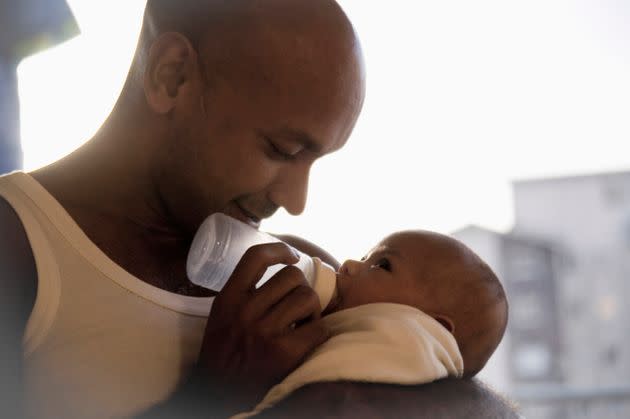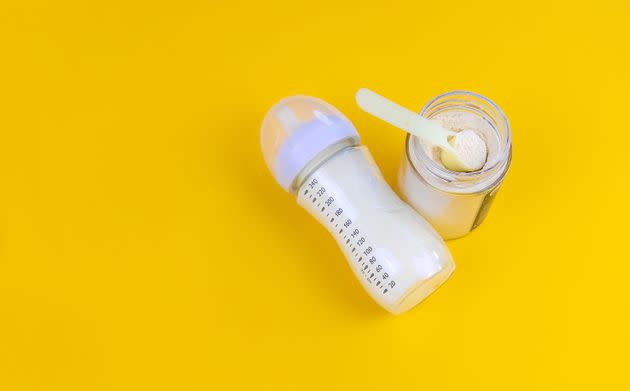Should You Freeze-Dry Your Breast Milk?
For most parents and babies, breast milk comes in two forms: liquid and solid ice. If you’re pumping or expressing breast milk, it needs to be used within four hours of leaving your body, or it can be kept refrigerated for up to four days or kept frozen for six to 12 months, according to the Centers for Disease Control and Prevention.
But there is a third, lesser-known option: Some companies offer services that will freeze-dry your breast milk as a powder, similar to formula.
This is accomplished by removing water from the milk via a process called sublimation. First, the milk is frozen in a specialized chamber at a very low temperature: minus 40 degrees Fahrenheit, much colder than your kitchen freezer. Then a pump takes air out of the chamber, decreasing the pressure.
Next, the temperature is gradually raised back up, causing the ice crystals to vaporize. The powder that is left behind can be reconstituted by simply adding the correct proportion of water before serving.
But should you freeze-dry your breast milk? Here are the most common questions about the process and how to figure out if it’s right for you.
Why do people freeze-dry their milk?
According to two companies that offer freeze-drying services, freeze-drying makes the milk shelf-stable and usable for up to three years. You don’t need to keep it in the refrigerator or freezer.
Removing the water from the milk also decreases its weight. If you’re pumping exclusively and have to lug full bottles and ice packs with you everywhere, you’ll understand the appeal. This also allows you to ship freeze-dried milk long distances at a lower cost, without worrying about it accidentally thawing and spoiling.
Frequent travel for work, concerns about milk expiring, worries about losing a stash or simply wanting freezer space back are some of the common reasons that parents decide to freeze-dry, said Berkley Luck, a co-founder of Milkify, a Houston-based business for freeze-drying breast milk. Military parents, who on short notice may have to pick up and move everything — including a stuffed freezer — have also made use of the service.
Some parents say that a baby who doesn’t like the taste of a parent’s frozen and defrosted milk will more readily take freeze-dried milk, according to Luck and Janna Hattingh, the owner of Booby Food, a company in Canada’s Alberta province that also freeze-dries breast milk.
Is it safe?
Freeze-drying foods is not new, but the companies using the process for breast milk are. There is limited research into the practice, and companies that freeze-dry breast milk fall under the category of “autologous use” — meaning that each client only receives their own milk. They are not directly regulated by the FDA.
“Right now there aren’t specific safety regulations, and [freeze-drying] is not yet recommended by the American Academy of Pediatrics or Centers for Disease Control,” Dr. Jen Trachtenberg, a pediatrician, told HuffPost.
“It is important for it to be reconstituted properly to ensure adequate nutrition for baby,” she added. This also holds true for infant formula.
In Canada, Alberta Health Services also does not recommend the use of freeze-dried breast milk “due to the lack of available evidence,” according to a statement on its website.
In the same statement, the provincial health authority said it did give a food handling permit to an unnamed business that freeze-dries clients’ breast milk. Hattingh told HuffPost that “Alberta health inspectors do physically come and visit our facility.”
Luck from Milkify told HuffPost that they voluntarily follow so-called Current Good Manufacturing Practice regulations from the Food and Drug Administration and that they follow CDC guidelines for the safe handling of breast milk, as well as guidelines from the Human Milk Banking Association of North America. Booby-Licious, a company that launched in June and is also based in Texas, said the same in an email to Huffpost.
However, because the services aren’t regulated by the FDA, parents should consider potential risks.

Freeze-dried breast milk can be mixed with water to make a bottle. (Photo: WIN-Initiative/Neleman via Getty Images)
Does the milk retain its beneficial properties?
While freeze-drying human milk is not a widespread practice, some research has focused on the topic. A 2014 study found that most of the nutrients, vitamins and proteins are preserved in the freeze-drying process, though with some loss of vitamin C.
“The overall caloric density of breast milk is not altered by freeze-drying,” Luck said. “In addition, proteins, fats and carbohydrates — including human milk oligosaccharides — were found to be protected by freeze-drying.”
This is noteworthy, as the nutritional content of human milk is impacted by regular freezing, with protein and caloric content decreasing over time.
Many of the beneficial antibodies in the milk appear to survive freeze-drying as well. A 2016 study found that 75% to 80% of certain antibodies were preserved when freeze-drying milk at particular temperatures.
Meanwhile, a 2015 study showed that freeze-drying did not impact the “bactericidal activity” of human milk, meaning that it still inhibited the growth of dangerous bacteria.
Researchers don’t know whether every component of human milk is preserved by freeze-drying (or by old-fashioned freezing, for that matter), as we don’t even know what all of them are and they differ from person to person. That said, there’s some evidence that freeze-drying is at least as good at preserving milk as freezing, and the milk may last much longer.
Can people freeze-dry breast milk themselves?
Multiple sources warn against freeze-drying milk on your own.
“There may be potential for contaminants in the freeze-drying process or storage, and it is not something I would recommend families to do themselves at home,” said Trachtenberg, the pediatrician.
People considering freeze-drying their milk with a dedicated company should do their due diligence with research and choose the company that best addresses their safety concerns.
“You need somebody with the specialized equipment and specialized skill set to be able to do it for you so that it’s done safely and packaged safely, and can be stored with peace of mind,” Luck said.
How does it work?
Karrie Locher, a postpartum nurse and mother of four in St. Louis, used Booby Food to freeze-dry some of her milk.
“I was incredibly worried about the international shipping,” Locher told HuffPost. But she decided to go with Booby Food because Milkify, which was closer to her home, didn’t have any availability.
Locher said that the most nerve-wracking part of the process was shipping the milk that she’d worked so hard to collect. Those who live near the freeze-drying companies can circumvent this step by using their local drop-off services.
“I was sent a ‘breast milk shipper,’ which consisted of a box, insulated cooler and prepaid shipping label inside. I packed up my frozen milk per the instructions and shipped it through FedEx,” said Locher.
“The owner [Hattingh] tracked it with me and assured me it would be just fine. She takes the cooler temps when it gets to her, and all of my milk was still frozen solid when it arrived,” Locher added.
Locher said she is saving most of her freeze-dried milk for later since it will last so long, but her son drank a bottle without issue and even ate some that she sprinkled into his dinner one evening.
A difference between the three North American companies HuffPost found is that Milkify and Booby-Licious both say they process milk one bag at a time, with each becoming a bag of freeze-dried powder that has its own water ratio for serving.
Booby Food, meanwhile, pools all of a person’s milk and divides the freeze-dried powder evenly into bags that have the same water ratio.
“Their water ratio is unique to their breast milk, and they don’t have to filter through different bags to find the right amount they need,” said Hattingh.

Freeze-dried human milk resembles infant formula and can be used in much the same way. (Photo: Yana Tatevosian / 500px via Getty Images)
How much do freeze-drying services cost?
Milkify charges $179 to process 100-120 ounces of milk, or $1.49 to $1.79 per ounce. Right now, the company is at capacity and clients can only place preorders for later. But it has a new, larger facility under construction that should allow it to process orders more quickly.
Booby Food’s services cost 249.99 Canadian dollars ($190) for up to 100 ounces of milk, or about CA$2.50 per ounce, with payment plans available.
Booby-Licious charges $210 for 100-120 ounces of milk, or $1.75-$2.10 per ounce.
All three companies offer different pricing for greater quantities of milk.
By comparison, a 21-ounce canister of Earth’s Best Organic infant formula on Amazon costs $27.82, or $1.32 per ounce. A 28.3-ounce canister of Enfamil formula is $41.99, or $1.48 per ounce.
What other options do I have for extra breast milk?
Even if it’ll be good for a few years, there may not be an advantage to freeze-drying milk that you’re never going to need. If you have a full freezer of meticulously collected liquid gold that you can’t bear to throw away, there are other options.
You can donate it to a milk bank that will process it for premature infants at hospitals. Find your closest milk bank on the Human Milk Banking Association of North America website and call to inquire about screening and donation.
If a milk bank can’t take your milk, perhaps because it has been in your freezer for too long — some won’t take milk after three months — you can still donate it informally to another parent. Ask in your local parenting groups on social media if anyone is looking for donated milk, or check the Human Milk 4 Human Babies or Eats on Feets pages. Be aware that there is some risk involved in informal milk donations, primarily for the recipient.
This article originally appeared on HuffPost and has been updated.
